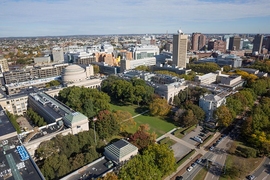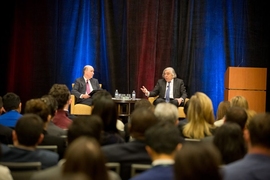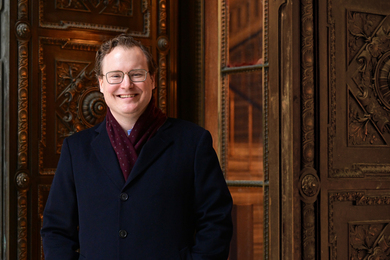More than 250 people gathered in the newly renovated Samberg Conference Center for the 8th annual MIT Sustainability Summit on April 15. This year’s theme was sustainability-oriented innovation (SOI), focused on creating value for customers while ensuring an environmentally and socially sustainable future. Thought leaders such as industry professionals, entrepreneurs, investors, policymakers, academics, and students convened on MIT’s campus to discuss the critical sustainability issues — and opportunities — society faces.
The day began with leaders in sustainability at MIT discussing the role of universities. The tripod keynote featured John Fernandez, director of the Environmental Solutions Initiative; Jason Jay, senior lecturer and director of the Sustainability Initiative at MIT; and Vladimir Bulović, associate dean for innovation at MIT. They urged universities to go beyond fostering an environment for innovation, and focus on scaling and building awareness beyond the walls of the institution and into business and society.
The discussion continued with a panel on sustainability leadership featuring sustainability and research and development leaders from across industries. The panelists stressed that data and metrics provide the backbone to a constantly evolving sustainability strategy. In order to influence the influencers, they argued that leaders need to get the numbers right, sell with a passion, remain nimble, and move quickly to outmaneuver the nay-sayers. Emerging leaders in sustainability need more than just polish and experience: They also need passion and tenacity coupled with empathy. These capacities enable sustainability professionals to provide “gentle nudging” to those who share an overall vision but may not be moving in the right direction.
The morning concluded with a structured networking session where tables for climate change policy, alternative protein, circular economy, and university sustainability were overflowing with attendees looking to learn, share, and connect. Among the many things overheard at the tables were lively discussions around data-driven policymaking, deal flow conversations between entrepreneurs and investors, corporate leaders sharing best practices, and experts debating different emerging technologies. One attendee expressed, “I alternated between frustration and excitement as I realized how far ahead some of the SOI research is compared to what companies are actually doing.”
Afternoon sessions included parallel tracks across three different areas: sustainability as a driver of corporate innovation; creating an SOI ecosystem through finance and policy; and accelerating innovation pipelines. Panelists included representatives from corporations such as JetBlue and L’Oreal; new ventures such as Uber; investors Flagship Ventures and Clean Energy Ventures Group; and the MassChallenge accelerator.
Several critical themes emerged during the day. First, organizations both big and small need to set a clear vision for the future of sustainability within the organization, and to make that the anchor point that drives the team forward. Second, entrepreneurs should deliver the sustainability aspects of their message using a narrative that resonates with their audience, as demonstrating empathy can strengthen a sense of community and motivation. Entrepreneurs need to be careful, however, not to push the sustainability aspects of their venture to investors who are primarily concerned about financial returns. Lastly, companies and new ventures need to embed SOI early on in the design and development process for new and existing products, supported by metrics and resources. As Johanna Jobin, director of global environmental health and safety and sustainability at Biogen, simplified, “What gets staffed gets done.”
The afternoon concluded with a keynote from Daniel Esty, the Hillhouse Professor of Environmental Law and Policy at Yale University and former head of the Connecticut Department of Energy and Environmental Protection. He posited that 2015 was a landmark year for sustainability with climate commitments from global leadership, Pope Francis’ call to action to address climate change, and the United Nations Sustainable Development Goals. Moreover, Esty illustrated how the Paris COP21 outcome stands apart from prior international climate agreements, emphasizing COP21’s focus on success, responsibility, execution, and adaptation as well as mitigation.
Esty placed innovation within a larger framework of change, which includes integration, incentives, investments and implementation. He issued a call to action for all four key stakeholder groups — entrepreneurs, corporations, investors, and all citizens — to create an ecosystem that fuels action through data-driven policies and decisions, effective incentives, and visionary investments.
Esty summarized a key sentiment from this year’s summit when he observed that “the status quo is not going to get us where we want to go — it is our biggest competitor and the biggest challenge.” Sustainability-oriented innovation can help turn this challenge into an opportunity.












